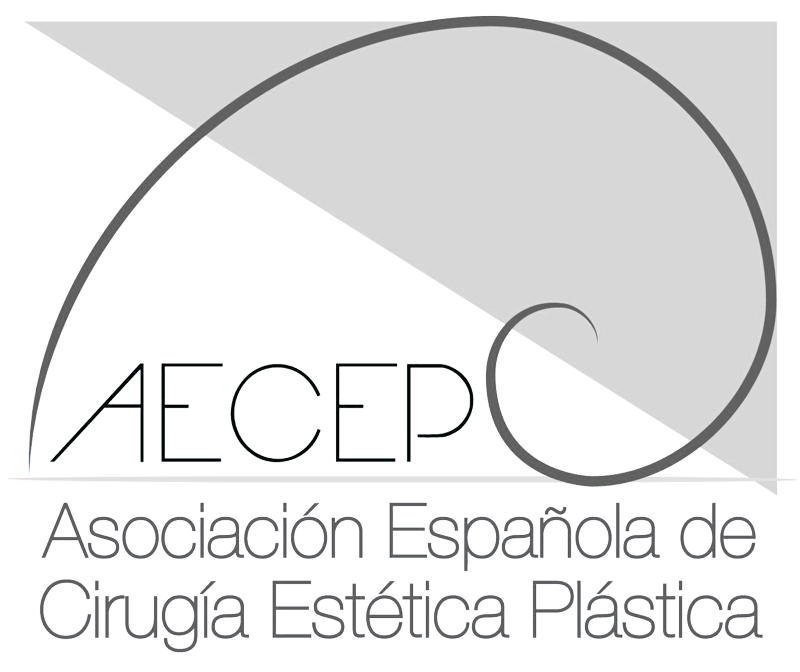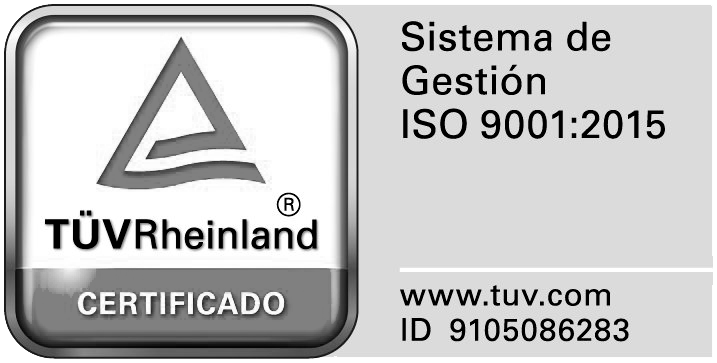
Rinoplastia:
operación de nariz

Rinoplastia
o cirugía de nariz
La rinoplastia es la cirugía que se utiliza para modificar la forma de la nariz y dar más armonía a la cara. Esta operación permite aumentar o disminuir el tamaño de la nariz, reducir las fosas nasales, cambiar la silueta de la punta o el tabique, o modificar el espacio entre la nariz y los labios. La operación de nariz también puede corregir algunos traumatismos o problemas respiratorios. El éxito de una rinoplastia está en conseguir un resultado natural y el óptimo equilibrio facial, de forma que la nariz no se aprecie como una nariz operada.
General
2 horas
1 día
7 días
Si estás deseando cambiar el tamaño o la forma de tu nariz, tienes dificultades respiratorias de tipo nasal además de querer cambiar su apariencia o has sufrido alguna lesión en la nariz, puedes considerar hacerte una rinoplastia.
Es importante tener claro qué resultados se pueden obtener con la rinoplastia, por lo que la fase más importante para la toma de una decisión es hablar con tu cirujano. En base a tus expectativas y al estudio de tu caso, el Dr. Paloma te explicará qué puedes esperar y el procedimiento más adecuado para llevar a cabo la operación. Además, podrás ver en nuestro simulador virtual Crisalix imágenes en 3D de cómo quedarías después de la cirugía estética de nariz.
El procedimiento de una rinoplastia consiste en separar la piel de su soporte de hueso y cartílago para esculpir ese soporte y luego adaptar la piel a la nueva forma. El cirujano puede hacer la rinoplastia desde dentro de la nariz con incisiones dentro de las fosas nasales o desde el exterior haciendo una pequeña incisión.
Una cirugía de nariz suele durar entre una y dos horas y habitualmente se lleva a cabo bajo anestesia general, aunque también se puede realizar con anestesia local y sedación. El paciente normalmente pasa una noche en el hospital después de la intervención. Al finalizar la rinoplastia se coloca una escayola y unos tapones en las fosas nasales para conservar la nueva forma de la nariz y estabilizar el tabique nasal.
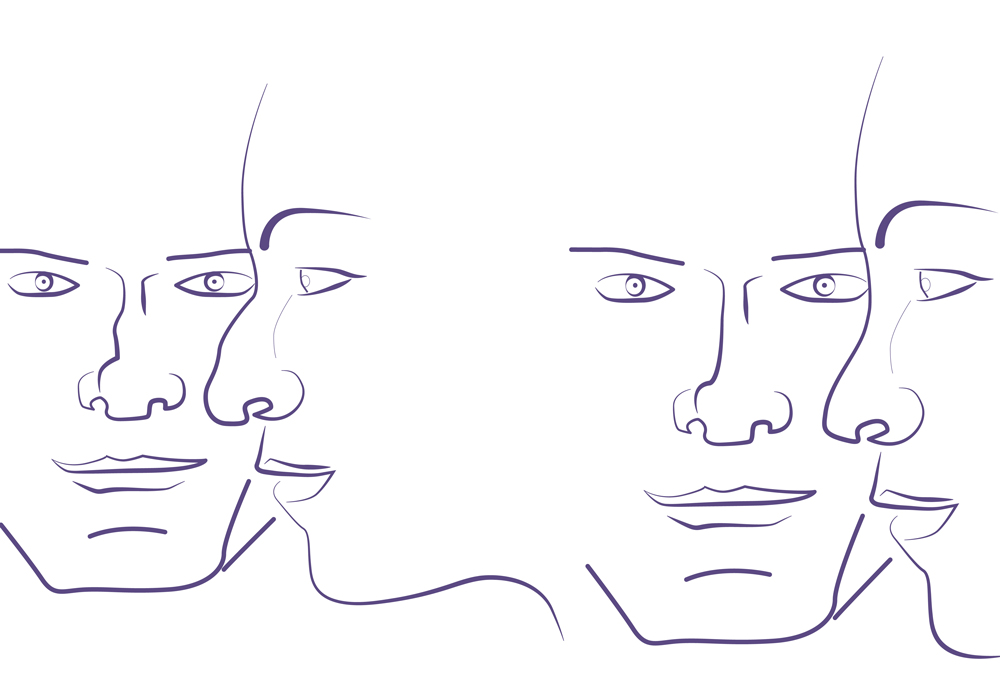
Aspecto tras una rinoplastia: El paciente presenta una nariz más equilibrada.
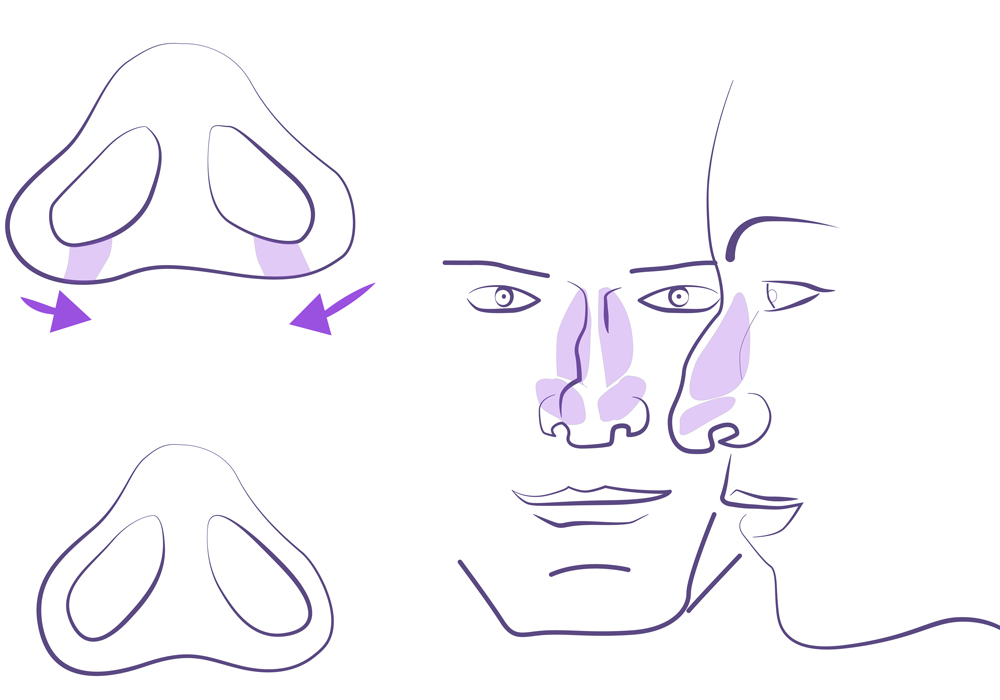
En ocasiones, si la base de la nariz es muy ancha, puede ser necesario extirpar unas pequeñas cuñas de piel. Las incisiones se realizan en el interior o en la base de la nariz, permitiendo remodelar los cartílagos y huesos de la nariz
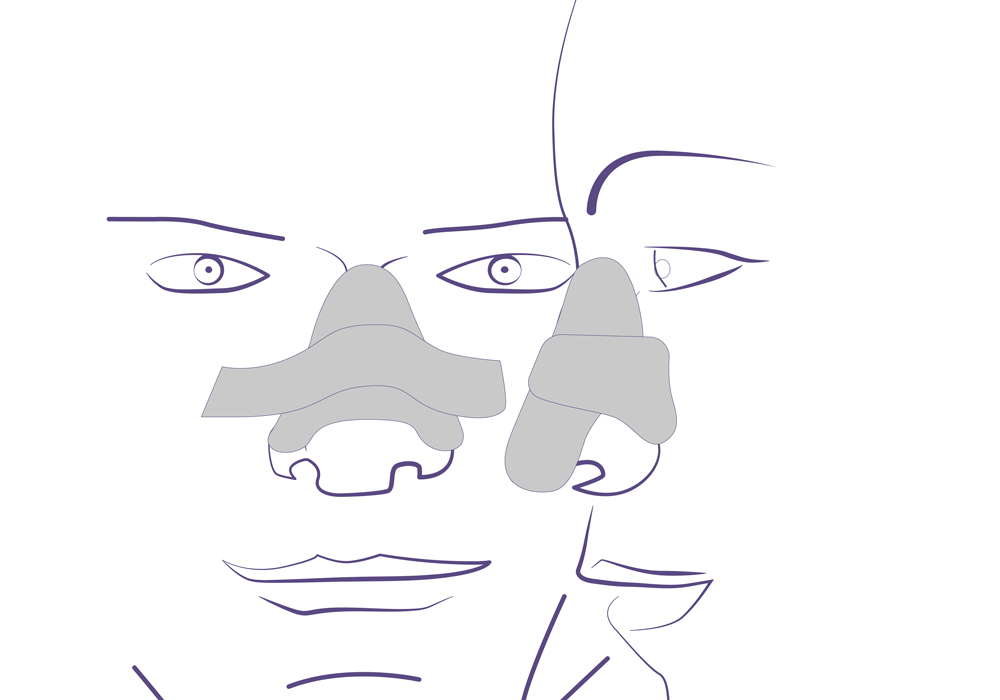
Se coloca una férula sobre la nariz durante el postoperatorio.
En la primera visita al cirujano plástico estudiará tus características faciales y el interior y exterior de la nariz.
Una vez examinadas las pruebas puede determinarse el procedimiento más adecuado para llevar a cabo la cirugía de nariz, mostrando al paciente imágenes virtuales del antes y el después obtenidas en nuestro simulador Crisalix.
Estas imágenes 3D son de gran ayuda para que cirujano y paciente concilien los objetivos deseados con la operación de nariz.
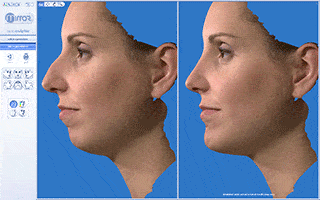
Simulador virtual Crisalix
Después de la rinoplastia, notarás la cara hinchada y molestias en la nariz que irán desapareciendo con el paso de los días y la medicación. Durante el primer día es necesario estar tumbado con la cabeza elevada y durante los 3 o 4 días posteriores dormir con la cabeza un poco incorporada. Los hematomas y la hinchazón desaparecerán casi por completo al cabo de 2 semanas.
Dos días después de la de la rinoplastia se retirarán los tapones nasales y al cabo de una semana se quitarán la férula y los puntos. Dos días después te sentirás bastante mejor y al cabo de una semana podrás volver a la actividad habitual. De todas maneras, tendrás que evitar algunas actividades físicas durante las primeras semanas, como la natación o el jogging y deberás tener cuidado al tocarte la nariz y lavarte la cara.
Cualquier intervención presenta riesgos, como infección o reacciones a la anestesia, pero en una operación de nariz las complicaciones no son habituales y suelen ser de muy poca importancia. Después de una rinoplastia no suelen quedar cicatrices visibles, pero en algunos casos aparecen pequeños puntos rojos en la zona.
Nuestro mayor éxito es lograr que después de la operación de nariz el paciente se sienta a gusto con su nueva armonía facial y vea un resultado natural sin que se vea una nariz operada.
Los primeros días después de una rinoplastia pueden ser difíciles ya que tendrás molestias y no apreciarás los resultados. No obstante, tu aspecto irá mejorando poco a poco y al cabo de una semana o dos te encontrarás muy bien sin apenas efectos visibles de la intervención.
Mediante ambas técnicas de rinoplastia podemos cambiar la forma de la nariz, perfilar la punta, ampliar o reducir ancho o largo, etc. modificando los cartílagos y el tabique nasal.
La diferencia fundamental radica en que la rinoplastia ultrasónica es una técnica basada en ultrasonidos que permite gran precisión con menos agresividad que la cirugía tradicional. La cirugía ultrasónica consiste en utilizar un dispositivo llamado Piezotomo para remodelar los huesos de la nariz sin lastimar los tejidos blandos ni los vasos sanguíneos, minimizando inflamación, hematomas y sangrado, y reduciendo las molestias para el paciente. Por todo ello, se ha convertido en la opción favorita de las personas que quieren operarse de la nariz.
Utilizamos el bisturí piezoeléctrico, un instrumento electromédico para la cirugía ósea que, a través de microondas de ultrasonidos, puede cortar cualquier tejido minuciosamente, permitiendo que el tejido blando permanezca ileso. Se realiza con una técnica abierta, que permite un campo de visión óptimo de las estructuras de la nariz.
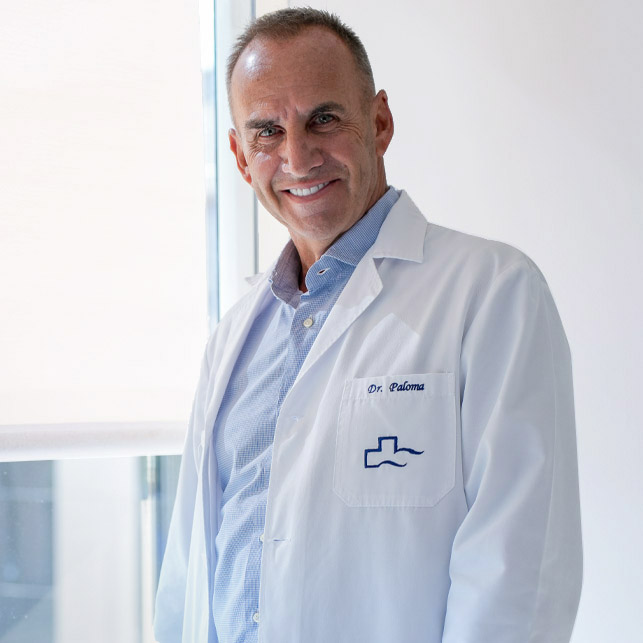
NÚMERO DE COLEGIADO: 32787
ESPECIALIDAD: Cirugía Plástica, Reparadora y Estética
SOCIEDADES CIENTÍFICAS: Miembro de la Sociedad Española de Cirugía Plástica, Reparadora y Estética (SECPRE)
REVISTA FORBES: Entre los 100 mejores médicos de España
SABER MÁS QUIERO PEDIR CITA

El precio de la rinoplastia depende de la técnica utilizada y de algunos aspectos que debemos valorar en la consulta y que determinarán el coste final de la cirugía de nariz para cada paciente.
Te ofrecemos a través de una entidad financiera de solvencia la posibilidad de financiar hasta el 100% de tu tratamiento al 0% de interés.
Después de una rinoplastia es normal experimentar hinchazón y cambios temporales en la apariencia de la nariz. Pueden pasar varios meses para poder ver el resultado final. Durante este tiempo, los tejidos y las estructuras internas se acomodan y se ajustan gradualmente.
No existe una edad mínima para someterse a una rinoplastia. En general, se sugiere esperar hasta la madurez física y mental del paciente. Madurez física para que el rostro y la nariz hayan alcanzado su desarrollo. En la mayoría de los casos, se recomienda que los pacientes sean mayores de 18 años antes de someterse a la cirugía ya que a esta edad es probable que la cara y la nariz hayan terminado de crecer.
Sí, es posible experimentar estornudos después de una cirugía de nariz, especialmente durante las primeras semanas de la recuperación. Esto puede deberse a varios factores como la irritación nasal, hinchazón y congestión de la nariz y cambios en la sensibilidad después de la operación.
Es posible que ocurra un ligero sangrado nasal, especialmente durante los primeros días de la recuperación. La rinoplastia es un procedimiento quirúrgico que requiere manipulación de los tejidos nasales, lo que puede causar irritación y sensibilidad en la zona.
Sí, es normal experimentar congestión nasal o tener la sensación de nariz tapada después de una rinoplastia. Durante la intervención se realizan modificaciones en la estructura nasal, lo que puede provocar hinchazón e inflamación de los tejidos internos. La congestión nasal generalmente disminuye a medida que progresa el proceso de curación y la hinchazón disminuye. Sin embargo, pueden pasar semanas, incluso meses, para que la secreción nasal desaparezca por completo.
No es común que una rinoplastia afecte la capacidad de sonreír. Sin embargo, es posible que experimentes cierta dificultad para sonreír o que notes cambios temporales en tu sonrisa después del procedimiento quirúrgico debido a la hinchazón y la sensibilidad en la zona de la nariz y la boca. Es importante tener en cuenta que estos cambios suelen ser temporales y tienden a desaparecer a medida que la hinchazón disminuye y los tejidos se recuperan.
La rinoplastia ultrasónica es un procedimiento mínimamente invasivo en comparación con la cirugía de nariz convencional. Por tanto, sí conlleva una recuperación más rápida. Esto se debe a que la rinoplastia ultrasónica, además de ser más precisa, ayuda a no generar tanto hematoma al disminuir el traumatismo. Además, también favorece a que no salga mucha hinchazón. Aunque todo esto depende de las características del paciente, pero por normal general sí que contribuye a una mejora en el postoperatorio.
Puede haber ciertas diferencias en el resultado estético de estos dos métodos de cirugía de la nariz. Aunque la finalidad de ambos tipos de cirugía busca mejorar la estética de la nariz, en el caso de la ultrasónica, al usar la técnica de ultrasonidos, el cirujano tiene mayor maniobrabilidad y precisión en la modelación del cartílago y de los huesos, lo que normalmente se traduce en resultados más naturales y una mejoría significativa del post operatorio.
De todas formas, es reseñable destacar la importancia de que el doctor especialista en cirugía plástica decida cuál de las dos técnicas es mejor para cada paciente, porque también dependerá mucho del tipo de nariz que tenga y las dificultades de la operación.
Sobre todo, la anatomía nasal que tiene el paciente, las expectativas de los resultados y, fundamentalmente, la decisión que tome el cirujano estético sobre la viabilidad de la rinoplastia. Algunos aspectos que pueden influir en la decisión de operarse la nariz, además de querer modificar el tamaño o la forma de la nariz, pueden ser problemas de tipo respiratorio, desviaciones del tabique nasal o fracturas.
Sí, la rinoplastia ultrasónica es algo más cara que la convencional porque estamos añadiendo una aparatología médica especial, un motor de ultrasonido. Se trata de un bisturí piezoeléctrico que permite al cirujano disponer de un campo de visión óptimo de las estructuras de la nariz, así como seccionar el tejido de forma minuciosa y mínimamente invasiva.
Si estás pensando en realizarte una rinoplastia, solicita una visita a través de este formulario o llama al
Descubre los últimos artículos y vídeos publicados sobre la operación de nariz o rinoplastia.



